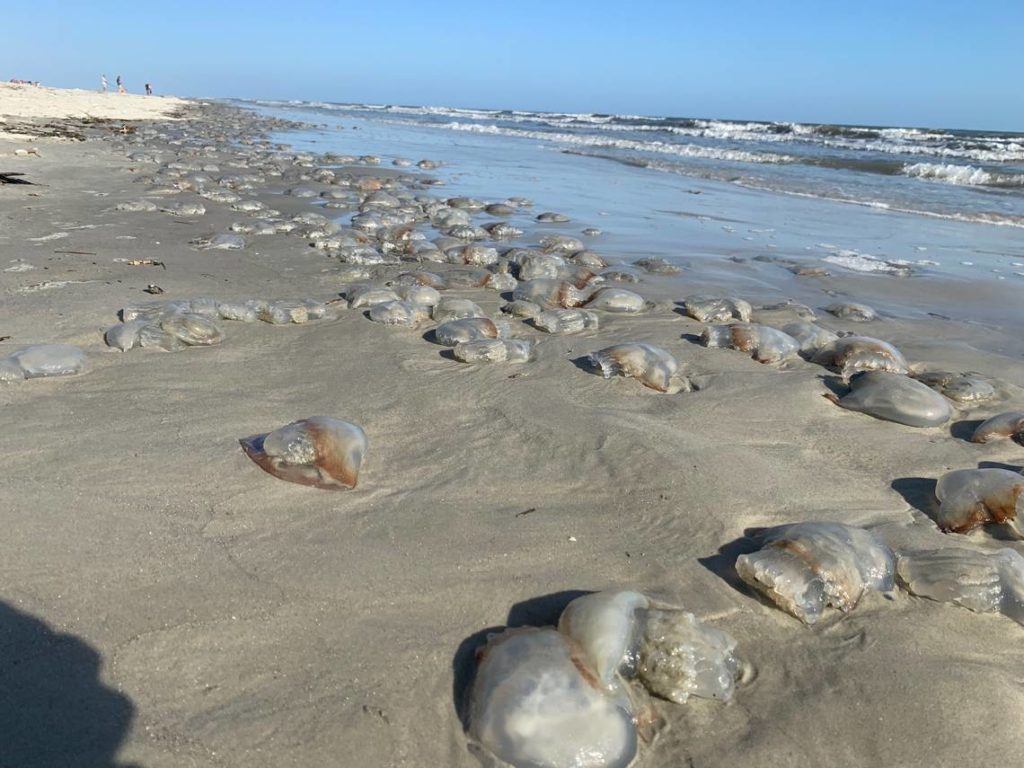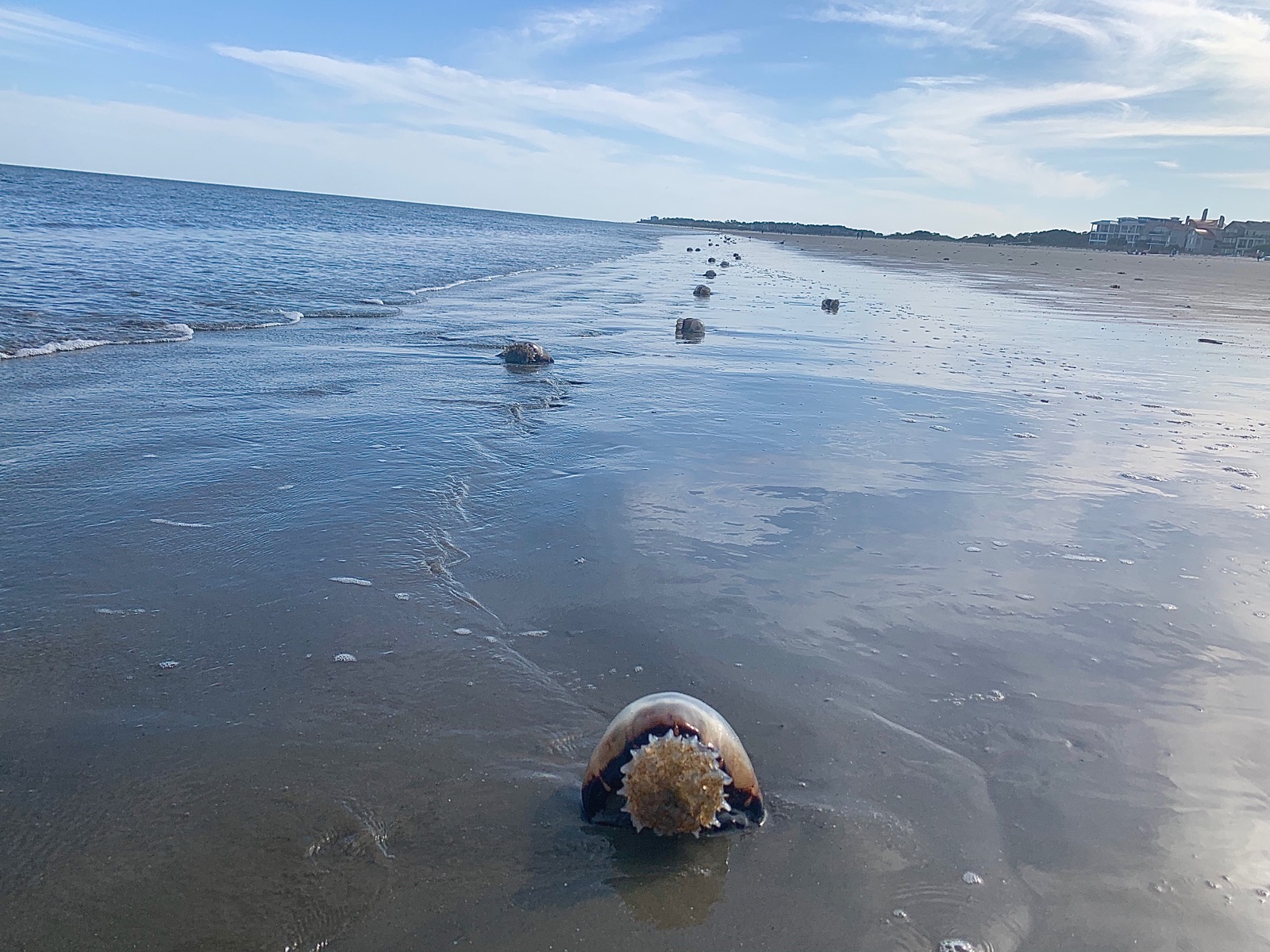Hilton Head‘s beaches are eerily empty right now and cluttered with dead jellyfish.
Thats right, thousands of dead jellyfish littered Hilton Head’s north end beaches on Friday.
No, the coronavirus isn’t reaching sea creatures, thankfully. And it isn’t a sign of the apocalypse (at least I hope not).
All those dead jellies on Hilton Head’s empty beaches are a reminder that despite all the madness happening in the human world, nature is still rolling through the circle of life.
On Friday, in an attempt to get my mind off all the stresses of the COVID-19 pandemic, I biked to the beach on Hilton Head Island.
While public beach access is closed, it’s still technically legal to exercise on the beach during Gov. Henry McMaster‘s “home or work” order (as far as I understand at least).
On Friday, the beaches were bizarre and bare. I kept a solid 25-foot distance from the few people I saw and made sure I didn’t touch anything.
While it was relieving to not see huge crowds at the beach like the disturbing scenes we saw a few weeks ago, it was still strange to see vacant beaches on such a beautiful spring day.
This time of the year, Hilton Head’s beaches are typically swarming with happy scenes — kids building sand castles, college kids tossing a football around, Labradors leaping across the water, that sort of thing.
But on Friday, everything about the beach felt out of place. The tide was abnormally low. The waves were feeble — almost nonexistent as if the ocean just wasn’t pushing anymore. And then, I looked at the ground.
Thousands of light brown cannonball jellyfish cluttered the beach from the shore to the tideline for miles up the coast.
The sight can be disturbing and baffling — especially with all those dead creatures laying on nearly deserted beaches.
But I’ve actually seen this — and written about it quite extensively — in the springtime before here on Hilton Head.
So what’s causing these jellyfish graveyards?
As the Post and Courier’s Bo Peterson explained: It’s those summer breezes causing the dead jellyfish clutters.
“Cannonball jellies tend to turn up in the nearshore waters during April, pushed in from the Gulf Stream with washes of warmer water,” Peterson wrote last spring. “They’re a sign that the surf is approaching that magic room-temperature zone a lot of people find plungeable on a hot day.”
But there’s a little more to it.
So jellyfish tend to travel in large blooms, and sometimes rough winds, swells and currents can knock hundreds of them out at once and send them all to shore in a sweep —making for quite the jellyfish graveyard.
“They often get pushed to shore as a group,” Blaine Griffen, a marine biologist at the University of South Carolina, previously told (me at) The Island Packet. “Sometimes, it’s the current, and some of them are just killed by annual population cycles.”

Also — it’s jellyfish blooming season in the Atlantic, the Marine Biology Association of the UK previously explained to us on Twitter. “If you’ve had onshore winds in the last few days, swarms of jellies can wash up.”
So jellyfish are really bad swimmers. They’re cold-blooded animals and can lose mobility when water temperatures are below normal. Because jellies are mostly made of water, so they die quickly after washing up on shore.
Most of these jellyfish washing up on the shore are cannonball jelly, which rarely sting while alive and if they do, the sting likely can’t be felt by a human. Cannonball jellyfish look like clear mushrooms with a brown border. They lose their color when they die and can’t hurt humans.
However, some jellyfish can sting you even after they die, so be cautious about touching any dead ones.
The Portuguese Man-of-War, which actually isn’t a jellyfish but a colony of organisms, can still sting humans after they die. Man-of-war jellies are sack-like creatures with bright blue and purple tentacles. They aren’t extremely common, but are sighted on South Carolina beaches every year.

What happens to all those dead jellies?
Because Friday’s tides were abnormally low in the afternoon, high tide likely swept away a lot of these rubbery creatures hours after I left.
Birds and crabs and other scavengers on the beach will eat up those jellies in no time.
One of South Carolina’s favorite marine animals — the sea turtle — loves to snack on jellyfish. Particularly leatherback sea turtles love to eat jellyfish. Sadly these creatures often confuse plastic bags with jellyfish.
Typically these big-ole jellyfish invasions are a sign that the sea turtles are not far behind.
Sea turtle season begins in early May, when loggerhead sea turtles lay their nests on South Carolina beaches. Because sea turtles are attracted to moonlight and often confuse it with artificial light, it’s extremely important to keep lights off the beaches from May to October of this year.
So summer is coming. Sea turtles are coming. Nature is taking its course as usual. The dead jellies are a sign of changing seasons — which we all need right now.

